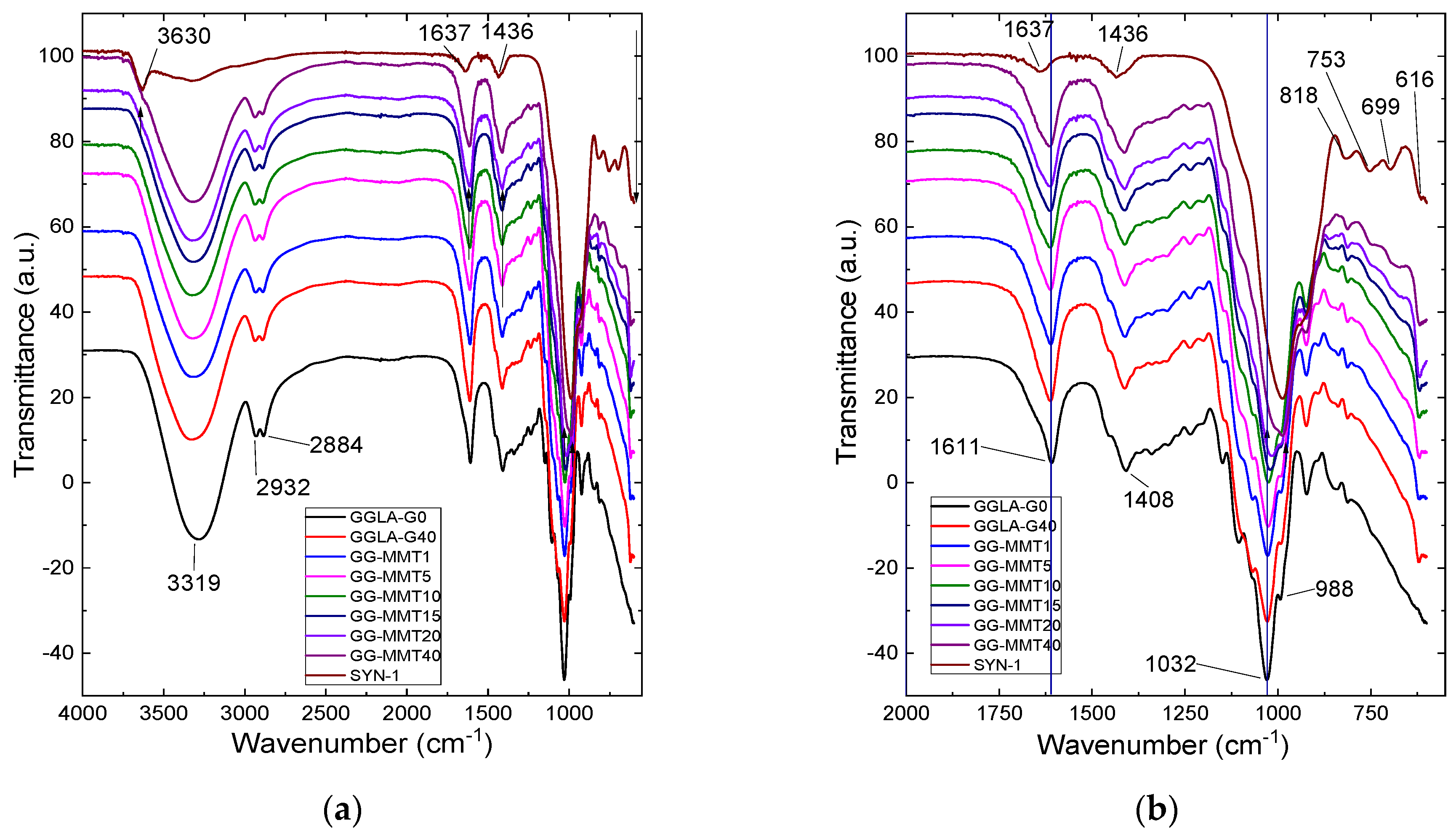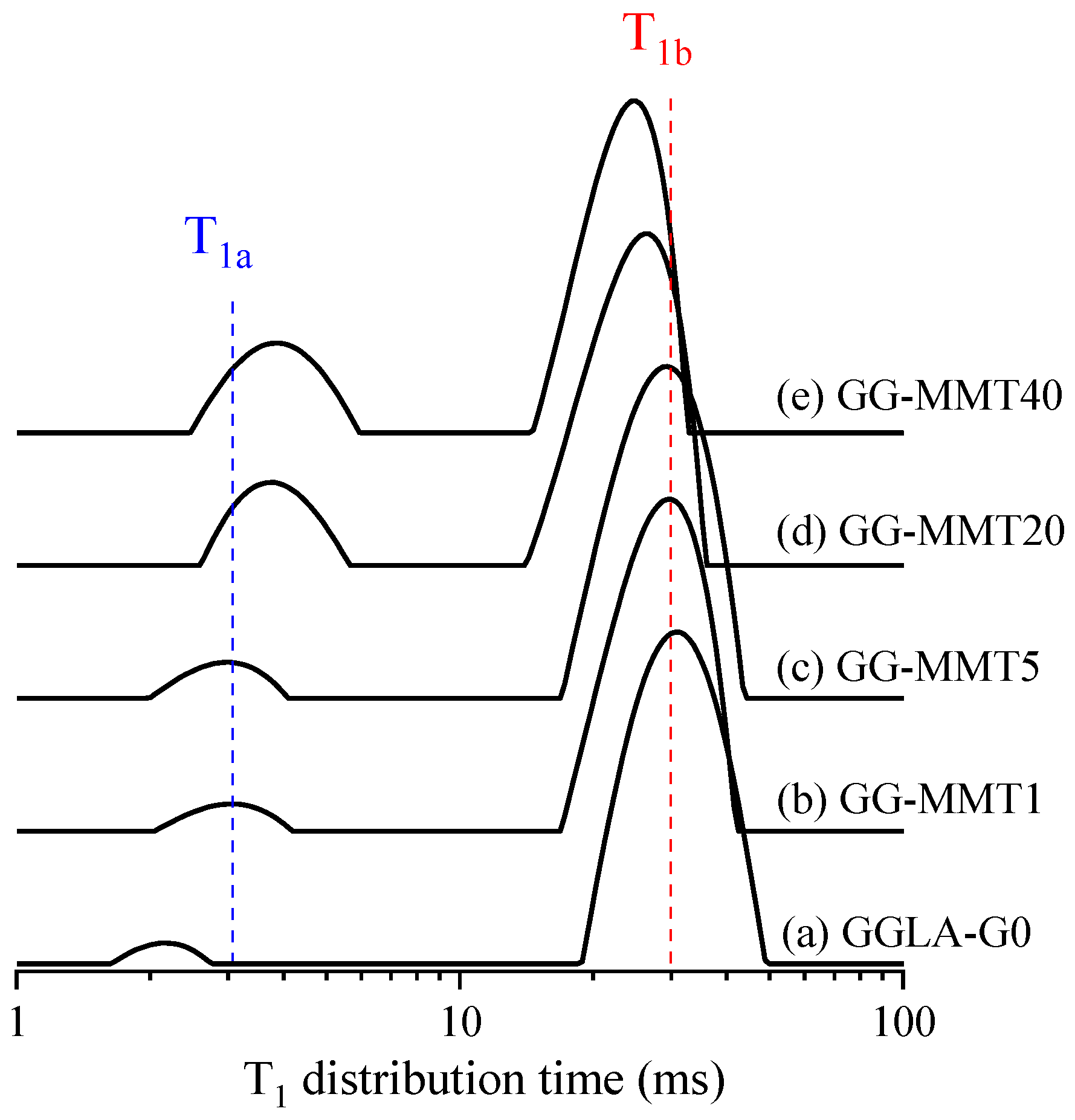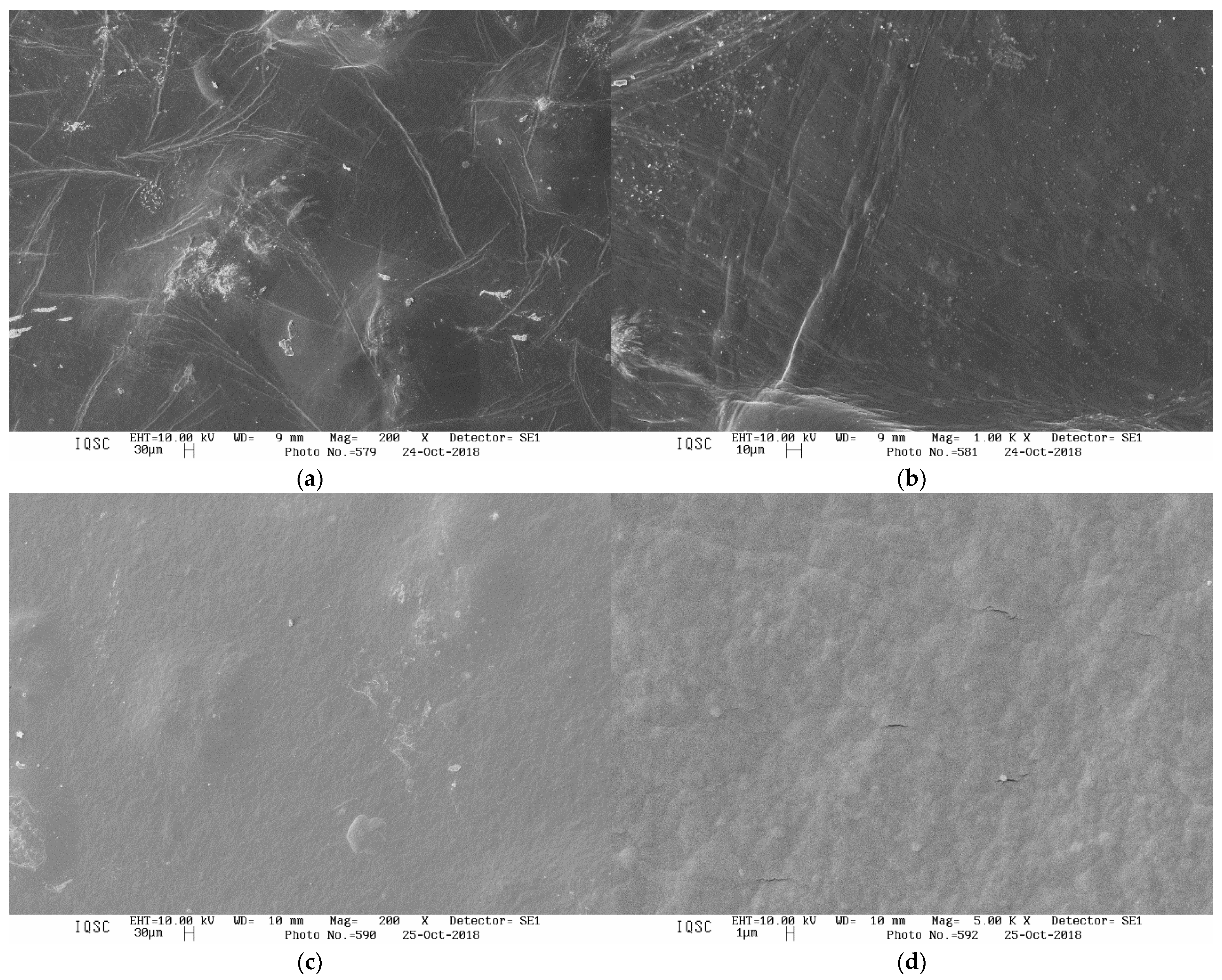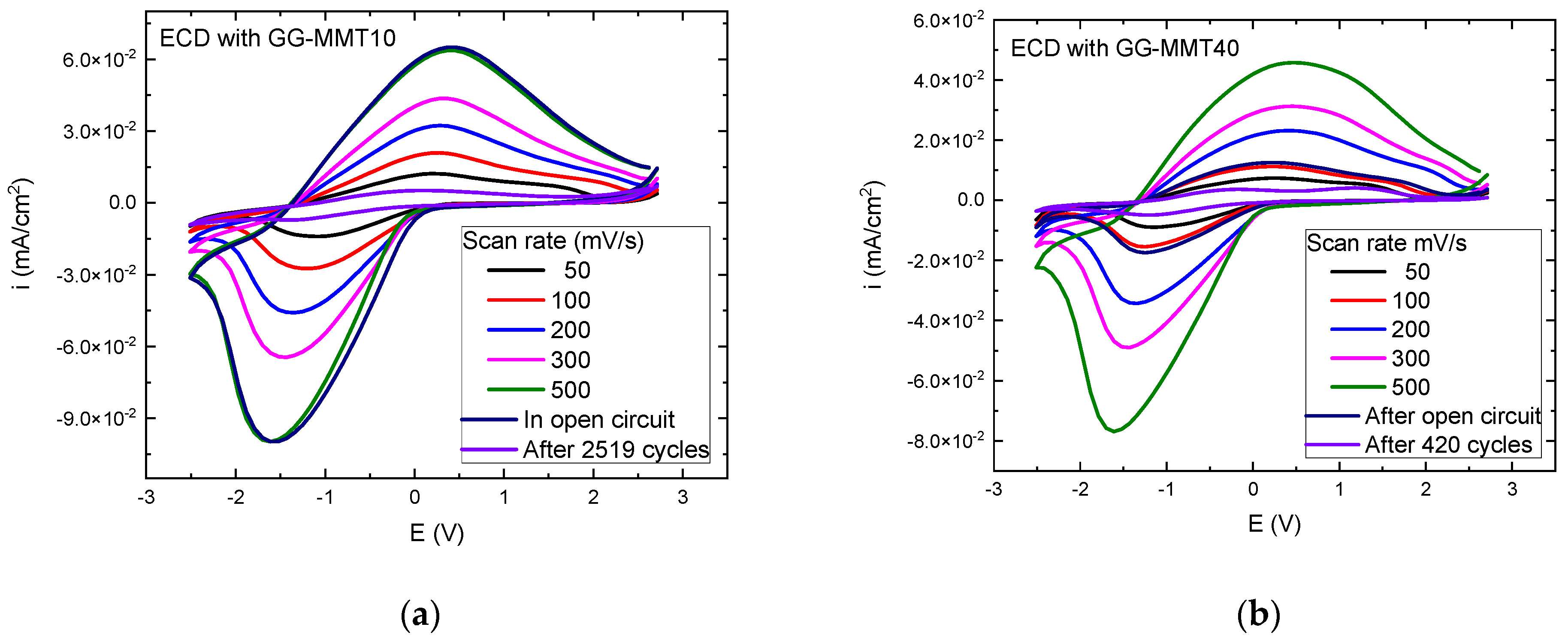Gellan Gum-Montmorillonite Nanocomposites for Electrochromic Devices
Abstract
:1. Introduction
2. Materials and Methods
3. Results and Discussion
3.1. ATR-FTIR Results
3.2. T1 TD-NMR
3.3. SEM Micrographs
3.4. Electrochromic Devices
3.4.1. Cyclic Voltammetry and Chronocoulometry
3.4.2. UV-Vis Reflectance and Transmission Spectroscopy of WO3-ECDs
4. Conclusions
Author Contributions
Funding
Institutional Review Board Statement
Informed Consent Statement
Data Availability Statement
Acknowledgments
Conflicts of Interest
References
- Adak, B.; Joshi, M.; Butola, B.S. Polyurethane/clay nanocomposites with improved helium gas barrier and mechanical properties: Direct versus master-batch melt mixing route. J. Appl. Polym. Sci. 2018, 135, 46422. [Google Scholar] [CrossRef]
- Pandey, P.; Mohanty, S.; Nayak, S.K. Improved flame retardancy and thermal stability of polymer/clay nanocomposites, with the incorporation of multiwalled carbon nanotube as secondary filler: Evaluation of hybrid effect of nanofillers. High Perform. Polym. 2014, 26, 826–836. [Google Scholar] [CrossRef]
- Narayanamoorthy, B.; Datta, K.; Eswaramoorthy, M.; Balaji, S. Improved oxygen reduction reaction catalyzed by pt/clay/Nafion nanocomposite for PEM fuel cells. ACS Appl. Mater. Int. 2012, 4, 3620–3626. [Google Scholar] [CrossRef] [PubMed]
- Sentanin, F.; Sabadini, R.; Barros, S.; Caliman, W.; Cavalheiro, C.; Kanicki, J.; Donoso, J.P.; Magon, C.J.; Silva, I.; Silva, M.; et al. Study of ionically conducting nanocomposites for reflective electrochromic devices. Electrochim. Acta 2019, 301, 174–182. [Google Scholar] [CrossRef]
- Valandro, S.R.; Lombardo, P.C.; Poli, A.L.; Horn, M.A., Jr.; Neumann, M.G.; Cavalheiro, C.C.S. Thermal properties of poly (methyl methacrylate)/organomodified montmorillonite nanocomposites obtained by in situ photopolymerization. Mat. Res. 2014, 17, 265–270. [Google Scholar] [CrossRef]
- Anwar, N.; Ishtiaq, M.; Shakoor, A.; Niaz, N.A.; Rizvi, T.Z.; Qasim, M.; Irfan, M.; Mahmood, A. Dielectric properties of polymer/clay nanocomposites. Polym. Polym. Comp. 2021, 29, 807–813. [Google Scholar] [CrossRef]
- Das, A.; Thakur, A.K. Role of clay intercalation in the structural, and thermal property of a polymer blend electrolyte. Mater. Today Proc. 2021, 47, 1665–1669. [Google Scholar] [CrossRef]
- Verma, G. Weathering, salt spray corrosion and mar resistance mechanism of clay (nano-platelet) reinforced polyurethane nanocomposite coatings. Prog. Org. Coat. 2019, 129, 260–270. [Google Scholar] [CrossRef]
- Echeverría, I.; López-Caballero, M.E.; Gómez-Guillén, M.C.; Mauri, A.N.; Montero, M.P. Active nanocomposite films based on soy proteins-montmorillonite-clove essential oil for the preservation of refrigerated bluefin tuna (Thunnus thynnus) fillets. Int. J. Food Microbiol. 2018, 266, 142–149. [Google Scholar] [CrossRef]
- Reddy, G.V.R.; Joshi, M.; Adak, B.; Deopura, B.L. Studies on the dyeability and dyeing mechanism of polyurethane/clay nanocomposite filaments with acid, basic and reactive dyes. Color. Technol. 2018, 134, 117–125. [Google Scholar] [CrossRef]
- Dyartanti, E.R.; Purwanto, A.; Widiasa, I.N.; Susanto, H. Ionic Conductivity and Cycling Stability Improvement of PVDF/Nano-Clay Using PVP as Polymer Electrolyte Membranes for LiFePO4 Batteries. Membranes 2018, 8, 36. [Google Scholar] [CrossRef] [PubMed]
- Lee, S.Y.; Ahn, J.-Y.; Kim, M.; Sekhon, S.S.; Cho, S.-J.; Kim, Y.-C.; Kim, Y.-H. Phenotypic and proteomic analysis of positively regulated gellan biosynthesis pathway in Sphingomonas elodea. Anim. Cells Syst. 2017, 21, 115–123. [Google Scholar] [CrossRef] [PubMed]
- Osmałek, T.; Froelich, A.; Tasarek, S. Application of gellan gum in pharmacy and medicine. Int. J. Pharm. 2014, 466, 328–340. [Google Scholar] [CrossRef]
- Noor, I.S.M.; Majid, S.R.; Arof, A.K.; Djurado, D.; Pawlicka, A. Characteristics of gellan gum-LiCF3SO3 polymer electrolyte. Solid State Ion. 2012, 225, 649–653. [Google Scholar] [CrossRef]
- Pacelli, S.; Paolicelli, P.; Moretti, G.; Petralito, S.; Di Giacomo, S.; Vitalone, A.; Casadei, M.A. Gellan gum methacrylate and laponite as an innovative nanocomposite hydrogel for biomedical applications. Eur. Polym. J. 2016, 77, 114–123. [Google Scholar] [CrossRef]
- Borah, S.; Deka, M. Study of electrical and electrochemical properties of P (VdF-HFP)-MMT based nanocomposite gel polymer electrolytes for application in energy storage devices. Mater. Sci. Eng. B 2021, 263, 114822. [Google Scholar] [CrossRef]
- Chen, R.S.; Ahmad, S.; Gan, S. Characterization of recycled thermoplastics-based nanocomposites: Polymer-clay compatibility, blending procedure, processing condition, and clay content effects. Compos. Part B Eng. 2017, 131, 91–99. [Google Scholar] [CrossRef]
- Sudhakar, Y.; Selvakumar, M.; Bhat, D.K. Investigations on thermo-mechanical properties of organically modified polymer clay nanocomposites for packaging application. Polym. Polym. Comp. 2021, 29, 1191–1199. [Google Scholar] [CrossRef]
- Jeon, Y.M.; Kim, S.; Lee, M.; Lee, W.B.; Park, J.H. Polymer-clay nanocomposite solid-state electrolyte with selective cation transport boosting and retarded lithium dendrite formation. Adv. Energy. Mater. 2020, 10, 2003114. [Google Scholar] [CrossRef]
- TaŞdelen, M.A.; AltinkÖk, Ç. In situ preparation of hetero-polymers/clay nanocomposites by CUAAC click chemistry. Turk. J. Chem. 2021, 45, 50–59. [Google Scholar] [CrossRef]
- Peng, W.; Feng, C.; Hou, J.; Zhang, R.; Sun, P.; Gao, Y.; Wang, X. Probing the Dynamic Structural Evolution of End-Functionalized Polybutadiene/Organo-Clay Nanocomposite Gels before and after Yielding by Nonlinear Rheology and 1H Double-Quantum NMR. Polymers 2022, 14, 1518. [Google Scholar] [CrossRef]
- Prasanth, R.; Shubha, N.; Hng, H.H.; Srinivasan, M. Effect of nano-clay on ionic conductivity and electrochemical properties of poly (vinylidene fluoride) based nanocomposite porous polymer membranes and their application as polymer electrolyte in lithium ion batteries. Eur. Polym. J. 2013, 49, 307–318. [Google Scholar] [CrossRef]
- Suter, J.L.; Groen, D.; Coveney, P.V. Chemically Specific Multiscale Modeling of Clay–Polymer Nanocomposites Reveals Intercalation Dynamics, Tactoid Self-Assembly and Emergent Materials Properties. Adv. Mater. 2015, 27, 966–984. [Google Scholar] [CrossRef] [PubMed]
- Moraes, T.B.; Monaretto, T.; Colnago, L.A. Rapid and simple determination of T1 relaxation times in time-domain NMR by Continuous Wave Free Precession sequence. J. Magn. Reson. 2016, 270, 1–6. [Google Scholar] [CrossRef] [PubMed]
- Monaretto, T.; Souza, A.; Moraes, T.B.; Bertucci-Neto, V.; Rondeau-Mouro, C.; Colnago, L.A. Enhancing signal-to-noise ratio and resolution in low-field NMR relaxation measurements using post-acquisition digital filters. Magn. Reson. Chem. 2019, 57, 616–625. [Google Scholar] [CrossRef] [PubMed]
- Esin, E. Li+ doped chitosan-based solid polymer electrolyte incorporated with PEDOT: PSS for electrochromic device. J. Turk. Chem. Soc. Sect. A Chem. 2019, 5, 1413–1422. [Google Scholar] [CrossRef]
- Puguan, J.M.C.; Kim, H. ZrO2-silane-graft-PVdFHFP hybrid polymer electrolyte: Synthesis, properties and its application on electrochromic devices. Electrochim. Acta 2017, 230, 39–48. [Google Scholar] [CrossRef]
- Wang, J.-Y.; Wang, M.-C.; Jan, D.-J. Synthesis of poly (methyl methacrylate)-succinonitrile composite polymer electrolyte and its application for flexible electrochromic devices. Sol. Energy Mater. Sol. Cells 2017, 160, 476–483. [Google Scholar] [CrossRef]
- Zhang, S.; Lei, P.; Fu, J.; Tong, X.; Wang, Z.; Cai, G. Solution-processable multicolor TiO2/polyaniline nanocomposite for integrated bifunctional electrochromic energy storage device. Appl. Surf. Sci. 2023, 607, 155015. [Google Scholar] [CrossRef]
- Reddy, G.A.; Shaik, H.; Kumar, K.N.; Shetty, H.D.; Jafri, R.I.; Naik, R.; Gupta, J.; Sattar, S.A.; Doreswamy, B. Synthesis, characterizations, and electrochromic studies of WO3 coated CeO2 nanorod thin films for smart window applications. Phys. B Cond. Matter 2022, 647, 414395. [Google Scholar] [CrossRef]
- Caliman, W.R.; Sentanin, F.C.; Sabadini, R.C.; Donoso, J.P.; Magon, C.J.; Pawlicka, A. Improved Conductivity in Gellan Gum and Montmorillonite Nanocomposites Electrolytes. Molecules 2022, 27, 8721. [Google Scholar] [CrossRef] [PubMed]
- Monaretto, T.; Andrade, F.D.; Moraes, T.B.; Souza, A.A.; deAzevedo, E.R.; Colnago, L.A. On resonance phase alternated CWFP sequences for rapid and simultaneous measurement of relaxation times. J. Magn. Reson. 2015, 259, 174–178. [Google Scholar] [CrossRef] [PubMed]
- Mitchell, J.; Chandrasekera, T.; Gladden, L. Numerical estimation of relaxation and diffusion distributions in two dimensions. Prog. Nucl. Mag. Res. Spec. 2012, 62, 34–50. [Google Scholar] [CrossRef] [PubMed]
- Assis, L.M.N.; Leones, R.; Kanicki, J.; Pawlicka, A.; Silva, M.M. Prussian blue for electrochromic devices. J. Electroanal Chem. 2016, 777, 33–39. [Google Scholar] [CrossRef]
- Madejova, J.; Komadel, P. Baseline studies of the clay minerals society source clays: Infrared methods. Clays Clay Miner. 2001, 49, 410–432. [Google Scholar] [CrossRef]
- Bertmer, M.; Wang, M.; Krueger, M.; Bluemich, B.; Litvinov, V.M.; van Es, M. Structural Changes from the Pure Components to Nylon 6− Montmorillonite Nanocomposites Observed by Solid-State NMR. Chem. Mater. 2007, 19, 1089–1097. [Google Scholar] [CrossRef]
- VanderHart, D.L.; Asano, A.; Gilman, J.W. Solid-state NMR investigation of paramagnetic nylon-6 clay nanocomposites. 2. Measurement of clay dispersion, crystal stratification, and stability of organic modifiers. Chem. Mater. 2001, 13, 3796–3809. [Google Scholar] [CrossRef]
- Zhang, X.; Dean, K.; Burgar, I.M. A high-resolution solid-state NMR study on starch–clay nanocomposites and the effect of aging on clay dispersion. Polym. J. 2010, 42, 689–695. [Google Scholar] [CrossRef]
- Samyn, F.; Bourbigot, S.; Jama, C.; Bellayer, S.; Nazare, S.; Hull, R.; Castrovinci, A.; Fina, A.; Camino, G. Crossed characterisation of polymer-layered silicate (PLS) nanocomposite morphology: TEM, X-ray diffraction, rheology and solid-state nuclear magnetic resonance measurements. Eur. Polym. J. 2008, 44, 1642–1653. [Google Scholar] [CrossRef]
- Xu, B.; Leisen, J.; Beckham, H.W.; Abu-Zurayk, R.; Harkin-Jones, E.; McNally, T. Evolution of clay morphology in polypropylene/montmorillonite nanocomposites upon equibiaxial stretching: A solid-state NMR and TEM approach. Macromolecules 2009, 42, 8959–8968. [Google Scholar] [CrossRef]
- Asano, A.; Shimizu, M.; Kurotsu, T. Effect of Paramagnetic Fe3+ on T 1H in PVA/montmorillonite-clay Nanocomposites. Chem. Lett. 2004, 33, 816–817. [Google Scholar] [CrossRef]
- Asano, A. NMR Studies on Polymer Materials. In Experimental Approaches of NMR Spectroscopy: Methodology and Application to Life Science and Materials Science; The Nuclear Magnetic Resonance Society of Japan, Ed.; Springer: Singapore, Singapore, 2018; pp. 313–339. [Google Scholar] [CrossRef]
- Bourbigot, S.; VanderHart, D.L.; Gilman, J.W.; Awad, W.H.; Davis, R.D.; Morgan, A.B.; Wilkie, C.A. Investigation of nanodispersion in polystyrene–montmorillonite nanocomposites by solid-state NMR. J. Polym. Sci. Part B Polym. Phys. 2003, 41, 3188–3213. [Google Scholar] [CrossRef]
- VanderHart, D.L.; Asano, A.; Gilman, J.W. NMR measurements related to clay-dispersion quality and organic-modifier stability in nylon-6/clay nanocomposites. Macromolecules 2001, 34, 3819–3822. [Google Scholar] [CrossRef]
- Xu, B.; Leisen, J.; Beckham, H.W. Nanoparticle dispersion in polymer nanocomposites by spin-diffusion-averaged paramagnetic enhanced NMR relaxometry: Scaling relations and applications. Phys. Chem. Chem. Phys. 2014, 16, 16790–16797. [Google Scholar] [CrossRef]
- Melo, C.d.; Garcia, P.S.; Grossmann, M.V.E.; Yamashita, F.; Dall′Antônia, L.H.; Mali, S. Properties of extruded xanthan-starch-clay nanocomposite films. Braz. Arch. Biol. Technol. 2011, 54, 1223–1333. [Google Scholar] [CrossRef]
- Leones, R.; Fernandes, M.; Sentanin, F.; Cesarino, I.; Lima, J.F.; Bermudez, V.d.Z.; Pawlicka, A.; Magon, C.J.; Donoso, J.P.; Silva, M.M. Ionically conducting Er3+-doped DNA-based biomembranes forelectrochromic devices. Electrochim. Acta 2014, 120, 327–333. [Google Scholar] [CrossRef]
- Alves, R.; Sentanin, F.; Sabadini, R.C.; Pawlicka, A.; Silva, M.M. Solid polymer electrolytes based on chitosan and Dy(CF3SO3)3 for electrochromic devices. Solid State Ion. 2017, 310, 112–120. [Google Scholar] [CrossRef]
- Eren, E.; Karaca, G.Y.; Koc, U.; Oksuz, L.; Oksuz, A.U. Electrochromic characteristics of radio frequency plasma sputtered WO3 thin films onto flexible polyethylene terephthalate substrates. Thin Solid Film. 2017, 634, 40–50. [Google Scholar] [CrossRef]
- Deniz, M.; Deligöz, H. Flexible self-assembled polyelectrolyte thin films based on conjugated polymer: Quartz cristal microbalance dissipation (QCM-D) and cyclic voltammetry analysis. Colloid Surf. A 2019, 563, 206–216. [Google Scholar] [CrossRef]
- Leones, R.; Sentanin, F.; Rodrigues, L.C.; Ferreira, R.A.S.; Marrucho, I.M.; Esperança, J.M.S.S.; Pawlicka, A.; Carlos, L.D.; Silva, M.M. Novel polymer electrolytes based on gelatin and ionic liquids. Opt. Mat. 2012, 36, 187–195. [Google Scholar] [CrossRef]
- Dong, D.; Wang, W.; Rougier, A.; Barnabé, A.; Dong, G.; Zhang, F.; Diao, X. Lithium trapping as a degradation mechanism of the electrochromic properties of all-solid-state WO 3//NiO devices. J. Mater. Chem. C 2018, 6, 9875–9889. [Google Scholar] [CrossRef]
- Tang, X.; Chen, G.; Liao, H.; Li, Z.; Zhang, J.; Luo, J. Unveiling mechanical degradation for a monolithic electrochromic device: Glass/ITO/WO3/LiClO4 (PEO)/TiO2/ITO/glass. Electrochim. Acta 2020, 329, 135182. [Google Scholar] [CrossRef]
- Han, T.; Dzakpasu, C.B.; Kim, D.; Kim, S.; Jeong, Y.-C.; Ryou, M.-H.; Lee, Y.M. Thin and porous polymer membrane-based electrochromic devices. J. Mater. Chem. C 2019, 7, 1042–1047. [Google Scholar] [CrossRef]
- Bard, A.J.; Faulkner, L.R. Electrochemical Methods: Fundamentals and Applications, 2nd ed.; Wiley: New York, NY, USA, 2000; p. 856. [Google Scholar] [CrossRef]
- Wen, R.-T.; Niklasson, G.A.; Granqvist, C.G. Sustainable rejuvenation of electrochromic WO3 films. ACS Appl. Mater. Int. 2015, 7, 28100–28104. [Google Scholar] [CrossRef]
- Chen, W.; Zhang, G.; Wu, L.; Liu, S.; Cao, M.; Yang, Y.; Peng, Y. Study of a Novel Electrochromic Device with Crystalline WO3 and Gel Electrolyte. Polymers 2022, 14, 1430. [Google Scholar] [CrossRef] [PubMed]
- Dong, D.; Wang, W.; Rougier, A.; Dong, G.; Da Rocha, M.; Presmanes, L.; Zrikem, K.; Song, G.; Diao, X.; Barnabé, A. Life-cycling and uncovering cation-trapping evidence of a monolithic inorganic electrochromic device: Glass/ITO/WO 3/LiTaO 3/NiO/ITO. Nanoscale 2018, 10, 16521–16530. [Google Scholar] [CrossRef] [PubMed]
- Applin, D.M.; Izawa, M.R.; Cloutis, E.A.; Gillis-Davis, J.J.; Pitman, K.M.; Roush, T.L.; Hendrix, A.R.; Lucey, P.G. Ultraviolet spectral reflectance of carbonaceous materials. Icarus 2018, 307, 40–82. [Google Scholar] [CrossRef]
- Atak, G.; Coşkun, Ö.D. Fabrication of an all solid-state electrochromic device using zirconium dioxide as an ion-conducting layer. Thin Solid Film. 2018, 664, 70–78. [Google Scholar] [CrossRef]







| Sample | Gellan Gum (g) | Na+SYN-1 (g) |
|---|---|---|
| GG-MMT1 | 1.0000 | 0.0100 |
| GG-MMT5 | 1.0000 | 0.0500 |
| GG-MMT10 | 1.0000 | 0.1000 |
| GG-MMT15 | 1.0000 | 0.1500 |
| GG-MMT20 | 1.0000 | 0.2000 |
| GG-MMT40 | 1.0000 | 0.4000 |
Disclaimer/Publisher’s Note: The statements, opinions and data contained in all publications are solely those of the individual author(s) and contributor(s) and not of MDPI and/or the editor(s). MDPI and/or the editor(s) disclaim responsibility for any injury to people or property resulting from any ideas, methods, instructions or products referred to in the content. |
© 2023 by the authors. Licensee MDPI, Basel, Switzerland. This article is an open access article distributed under the terms and conditions of the Creative Commons Attribution (CC BY) license (https://creativecommons.org/licenses/by/4.0/).
Share and Cite
Caliman, W.R.; Sentanin, F.C.; Sabadini, R.C.; Garcia, R.H.S.; Monaretto, T.; Colnago, L.A.; Pawlicka, A. Gellan Gum-Montmorillonite Nanocomposites for Electrochromic Devices. Coatings 2023, 13, 350. https://doi.org/10.3390/coatings13020350
Caliman WR, Sentanin FC, Sabadini RC, Garcia RHS, Monaretto T, Colnago LA, Pawlicka A. Gellan Gum-Montmorillonite Nanocomposites for Electrochromic Devices. Coatings. 2023; 13(2):350. https://doi.org/10.3390/coatings13020350
Chicago/Turabian StyleCaliman, Willian R., Franciani C. Sentanin, Rodrigo C. Sabadini, Rodrigo H. S. Garcia, Tatiana Monaretto, Luiz A. Colnago, and Agnieszka Pawlicka. 2023. "Gellan Gum-Montmorillonite Nanocomposites for Electrochromic Devices" Coatings 13, no. 2: 350. https://doi.org/10.3390/coatings13020350
APA StyleCaliman, W. R., Sentanin, F. C., Sabadini, R. C., Garcia, R. H. S., Monaretto, T., Colnago, L. A., & Pawlicka, A. (2023). Gellan Gum-Montmorillonite Nanocomposites for Electrochromic Devices. Coatings, 13(2), 350. https://doi.org/10.3390/coatings13020350







